Welcome to the latest selection of recent top articles in the physica status solidi journals. Get a glimpse of our publication spectrum and visit our pages by clicking on any of the DOI links below.
Au–Ge bonding on uniformly Au-covered Ge(001) surface [Rapid Research Letter]
Dana G. Popescu and Marius A. Husanu
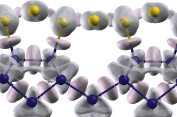 In the context of recently emerging Au/Ge(001) one-dimensional systems, the authors investigate the chemical bonding of one monolayer Au deposited on a dimerized Ge(001) surface. Effects on the covalent bonding of Au on the Ge dimer surface are shown combining photoelectron spectroscopy with first-principles calculations.
In the context of recently emerging Au/Ge(001) one-dimensional systems, the authors investigate the chemical bonding of one monolayer Au deposited on a dimerized Ge(001) surface. Effects on the covalent bonding of Au on the Ge dimer surface are shown combining photoelectron spectroscopy with first-principles calculations.
Phys. Status Solidi RRL (2013) DOI 10.1002/pssr.pssr.201307029
Calibration of excitonic photoluminescence to determine high aluminum concentrations in silicon [Rapid Research Letter]
Kevin Lauer, Christian Möller, Dirk Schulze, Til Bartel, and Fritz Kirscht
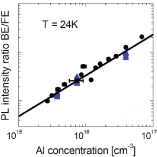 The photoluminescence intensity ratio of the aluminum bound exciton and the free exciton in silicon is calibrated with respect to the aluminum concentration. Photoluminescence measurements are performed at elevated temperatures around 20 K to assess the aluminum concentration range from 1015 to 1017 atoms/cm3. The obtained results open up the possibility to determine high aluminum concentrations in silicon using photoluminescence spectroscopy. This is in particular important for solar silicon.
The photoluminescence intensity ratio of the aluminum bound exciton and the free exciton in silicon is calibrated with respect to the aluminum concentration. Photoluminescence measurements are performed at elevated temperatures around 20 K to assess the aluminum concentration range from 1015 to 1017 atoms/cm3. The obtained results open up the possibility to determine high aluminum concentrations in silicon using photoluminescence spectroscopy. This is in particular important for solar silicon.
Phys. Status Solidi RRL (2013) DOI 10.1002/pssr.201307028
Advantages of blue InGaN light-emitting diodes with composition-graded barriers and electron-blocking layer [Original Paper]
Jih-Yuan Chang and Yen-Kuang Kuo
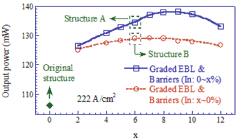 Numerical investigation on the influences of graded barriers and graded elec-tron-blocking layer (EBL) in blue InGaN light-emitting diodes (LEDs) is pre-sented by Chang and Kuo. When both the graded barriers and graded EBL are employed simultaneously, the LED structures benefit from both superior hole-injection efficiency and enhanced carrier transportation in the active region. The carrier distribution among the quantum wells becomes more uniform, which results in an improved radiative recombination rate and reduced Auger recombination. If the grading scheme of indium composition in the barriers is well designed, an optimal situation can be obtained. For the optimal structure in this study (In: 0∼9%), the output power at 222 A/cm2 is increased by 30% when com-pared to the original structure.
Numerical investigation on the influences of graded barriers and graded elec-tron-blocking layer (EBL) in blue InGaN light-emitting diodes (LEDs) is pre-sented by Chang and Kuo. When both the graded barriers and graded EBL are employed simultaneously, the LED structures benefit from both superior hole-injection efficiency and enhanced carrier transportation in the active region. The carrier distribution among the quantum wells becomes more uniform, which results in an improved radiative recombination rate and reduced Auger recombination. If the grading scheme of indium composition in the barriers is well designed, an optimal situation can be obtained. For the optimal structure in this study (In: 0∼9%), the output power at 222 A/cm2 is increased by 30% when com-pared to the original structure.
Phys. Status Solidi A (2013) DOI 10.1002/pssa.201228764
Magnetostrictive Fe–Ga alloy strips with a preferred orientation for lamination actuators [Original Paper]
Suok-Min Na, Andrew Passel, Patrick Downey, and Alison Flatau
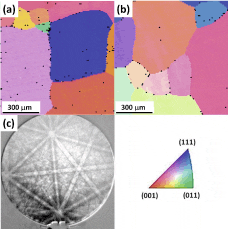 This work investigates the suitability for incorporating rolled sheets of NbC-containing Galfenol (Fe–Ga alloys) in the construction of laminated magnetostrictive actuators. All samples were quenched after annealing, and yet showed good flatness and resistance to thermal shock. A maximum value of 183 ppm was obtained in samples annealed under argon at 1250 °C for 2 h in rolled (Fe81Ga19)99(NbC)1 alloy. The dynamic actuation of the laminated rod constructed from the rolled strips was demonstrated in comparison with a solid rod of polycrystalline binary alloy. The electrical impedance data for the laminated rod displayed a reduction in eddy current formation, and this rod produced constant dynamic strains up to the maximum frequency tested (200 Hz), while the solid rod strain output began to roll off above ∼20 Hz.
This work investigates the suitability for incorporating rolled sheets of NbC-containing Galfenol (Fe–Ga alloys) in the construction of laminated magnetostrictive actuators. All samples were quenched after annealing, and yet showed good flatness and resistance to thermal shock. A maximum value of 183 ppm was obtained in samples annealed under argon at 1250 °C for 2 h in rolled (Fe81Ga19)99(NbC)1 alloy. The dynamic actuation of the laminated rod constructed from the rolled strips was demonstrated in comparison with a solid rod of polycrystalline binary alloy. The electrical impedance data for the laminated rod displayed a reduction in eddy current formation, and this rod produced constant dynamic strains up to the maximum frequency tested (200 Hz), while the solid rod strain output began to roll off above ∼20 Hz.
Phys. Status Solidi A (2013) DOI 10.1002/pssa.201228743
Vibrational spectroscopic studies on pure and metal-covered metal oxide surfaces [Feature Article]
Heshmat Noei, Lanying Jin, Hengshan Qiu, Mingchun Xu, Youkun Gao, Jianli Zhao, Max Kauer, Christof Wöll, Martin Muhler, and Yuemin Wang
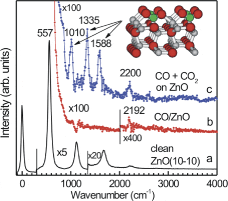 Metal oxides and metal nanoparticles dispersed on oxide substrates have gained increasing interest in surface science because of their widespread applications, especially in heterogeneous catalysis. Noei et al. summarize recent vibrational spectroscopic studies on pure and metal-covered oxide surfaces (ZnO, TiO2, Au/ZnO and Cu/ZnO) using a number of small molecules (H2, CO, CO2, NO, HCOOH) as probes and/or reactants. High resolution electron energy loss spectroscopy (HREELS) turned out to be a powerful tool to investigate well-defined oxide and metal/oxide model systems. The application of a novel ultrahigh vacuum IR spectroscopy (UHV-FTIRS) apparatus allowed to record high-quality IR data on oxide surfaces of both single crystals and polycrystalline powder particles.
Metal oxides and metal nanoparticles dispersed on oxide substrates have gained increasing interest in surface science because of their widespread applications, especially in heterogeneous catalysis. Noei et al. summarize recent vibrational spectroscopic studies on pure and metal-covered oxide surfaces (ZnO, TiO2, Au/ZnO and Cu/ZnO) using a number of small molecules (H2, CO, CO2, NO, HCOOH) as probes and/or reactants. High resolution electron energy loss spectroscopy (HREELS) turned out to be a powerful tool to investigate well-defined oxide and metal/oxide model systems. The application of a novel ultrahigh vacuum IR spectroscopy (UHV-FTIRS) apparatus allowed to record high-quality IR data on oxide surfaces of both single crystals and polycrystalline powder particles.
Phys. Status Solidi B (2013) DOI 10.1002/pssb.201248534
MOF-FF – A flexible first-principles-derived force field for metal-organic frameworks [Feature Article]
Sareeya Bureekaew, Saeed Amirjalayer, Maxim Tafipolsky, Christian Spickermann, Tapta Kanchan Roy, and Rochus Schmid
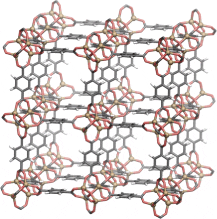 The development, definition and selected applications of a new force field for metal-organic frameworks MOF-FF are presented here. MOF-FF is fully flexible and is parameterized in a systematic and consistent fashion from first prin-ciples reference data. It can be used for a variety of different MOF-families and in particular – due to the reparametrization of a variety of organic linkers – also to explore isoreticular series of systems. The history of the development, leading to the final definition of MOF-FF is reviewed along with the application of the previous incarnations of the force field. In addition, the parametrization approach is explained in a tutorial fashion. The currently parametrized set of inorganic building blocks is constantly extended.
The development, definition and selected applications of a new force field for metal-organic frameworks MOF-FF are presented here. MOF-FF is fully flexible and is parameterized in a systematic and consistent fashion from first prin-ciples reference data. It can be used for a variety of different MOF-families and in particular – due to the reparametrization of a variety of organic linkers – also to explore isoreticular series of systems. The history of the development, leading to the final definition of MOF-FF is reviewed along with the application of the previous incarnations of the force field. In addition, the parametrization approach is explained in a tutorial fashion. The currently parametrized set of inorganic building blocks is constantly extended.
Phys. Status Solidi B (2013) DOI 10.1002/pssb.201248460
















